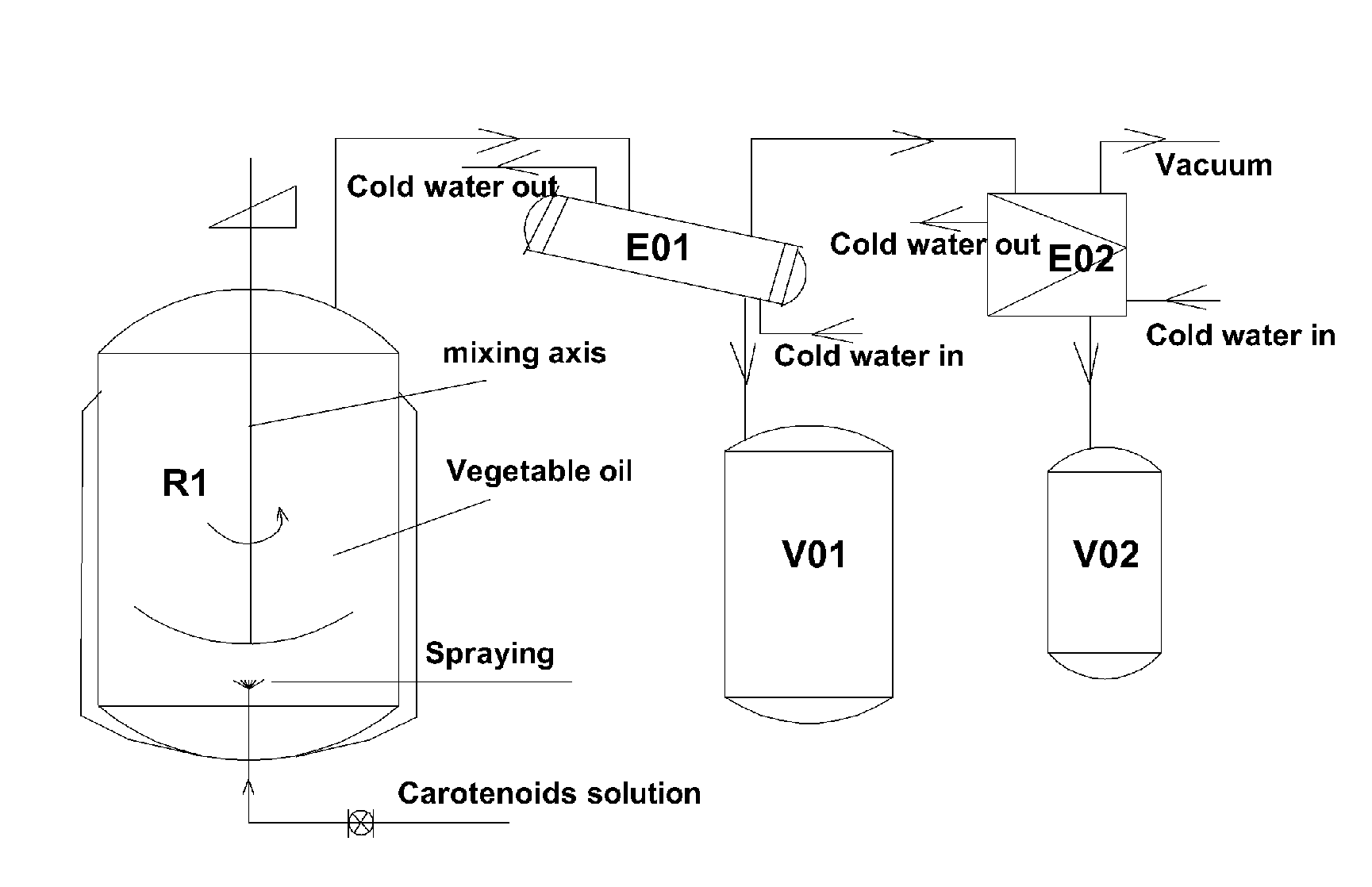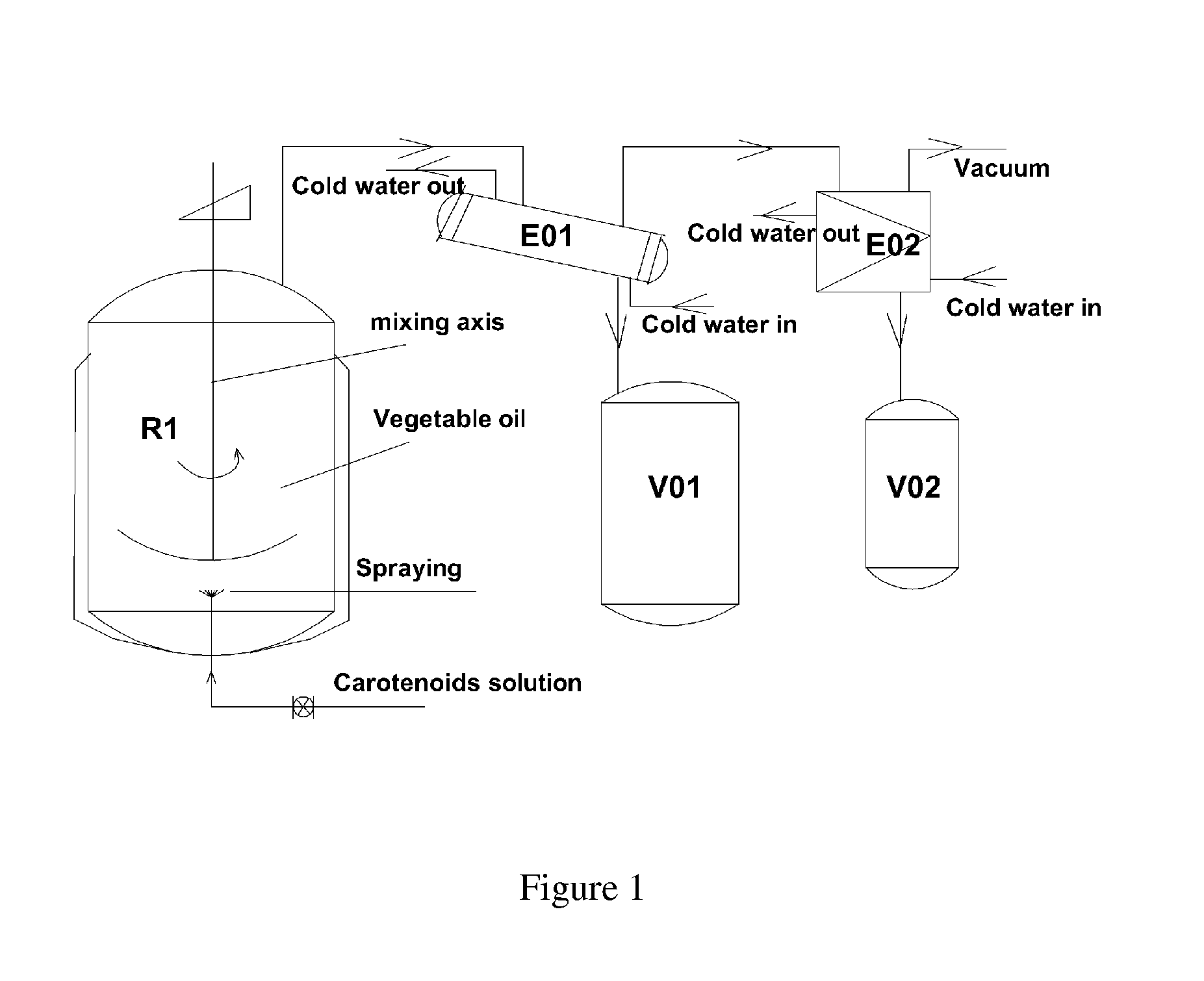Carotenoid Oil Suspension With High Bioavailability And Preparation Method Thereof
- Summary
- Abstract
- Description
- Claims
- Application Information
AI Technical Summary
Benefits of technology
Problems solved by technology
Method used
Image
Examples
example 1
[0032]18.3 kg xanthophyll crystal (content of 82.5%) is weighed and sufficiently mixed with 370 kg dichloromethane, the temperature is raised to 40° C. under stirring to dissolve the xanthophyll crystal to obtain a xanthophyll solution. Meanwhile, 273 kg soybean oil and 9 kg tocopherols is mixed in the reaction kettle R1, the temperature is raised to 30° C. and kept at the temperature, and vacuumized to keep a negative pressure state, and then stirred in a high-speed, the xanthophyll solution is sprayed by a rapidly rotating nozzle and introduced into soybean oil solution under a high-speed stirring, the organic solvent of dichloromethane in xanthophyll solution is sprayed and immediately volatilized under vacuum and then cooled into the tanks V01 and V02 after passing through the heat exchangers E01 and E02, and the organic solvent of dichloromethane may be circularly used.
[0033]The recovering of dichloromethane is finished when completion of spraying xanthophyll solution. 100 kg x...
example 2
[0034]103 kg β-carotene crystal (content of 98.5%) is weighed and sufficiently mixed with 1000 kg tetrahydrofuran and 10 kg ascorbyl palmitate, the temperature is raised to 40° C. under stirring to dissolve the β-carotene crystal to obtain a β-carotene solution. Meanwhile, 90 kg sunflower oil and corn oil (w / w=1:1) is mixed into a reaction kettle R1, and 300 kg absolute alcohol is mixed into the reaction kettle in order to reduce the viscosity of solution, the temperature is raised to 40° C. and kept at the temperature, and vacuumized to keep a negative pressure state, and then stirred in a high-speed, the β-carotene solution is sprayed by a rapidly rotating nozzle and introduced into vegetable oil solution under a high-speed stirring, the organic solvent of tetrahydrofuran in β-carotene solution is sprayed and immediately volatilized under vacuum at this temperature, and then cooled into the tanks V01 and V02 after passing through the heat exchangers E01 and E02, and the organic so...
example 3
[0035]74 kg zeaxanthin crystal (content of 81.5%) is weighed and sufficiently mixed with 1200 kg dichloromethane, the temperature is raised to 40° C. under stirring to dissolve the zeaxanthin crystal to obtain a zeaxanthin solution. Meanwhile, 211 kg colza oil and peanut oil (w / w=1:2) and 15 kg tocopherols is mixed to a reaction kettle R1, and 300 kg isopropanol is mixed into the reaction kettle in order to reduce the viscosity of solution, the temperature is raised to 30° C. and kept at the temperature, and vacuumized to keep a negative pressure state, and then stirred in a high-speed, the zeaxanthin solution is sprayed by a rapidly rotating nozzle and introduced into vegetable oil solution under a high-speed stirring, the organic solvent of dichloromethane in zeaxanthin solution is sprayed and immediately volatilized under vacuum at this temperature, and then cooled into the tanks V01 and V02 after passing through the heat exchangers E01 and E02, and the organic solvent of dichlor...
PUM
| Property | Measurement | Unit |
|---|---|---|
| Temperature | aaaaa | aaaaa |
| Particle size | aaaaa | aaaaa |
| Temperature | aaaaa | aaaaa |
Abstract
Description
Claims
Application Information
 Login to View More
Login to View More - R&D
- Intellectual Property
- Life Sciences
- Materials
- Tech Scout
- Unparalleled Data Quality
- Higher Quality Content
- 60% Fewer Hallucinations
Browse by: Latest US Patents, China's latest patents, Technical Efficacy Thesaurus, Application Domain, Technology Topic, Popular Technical Reports.
© 2025 PatSnap. All rights reserved.Legal|Privacy policy|Modern Slavery Act Transparency Statement|Sitemap|About US| Contact US: help@patsnap.com


